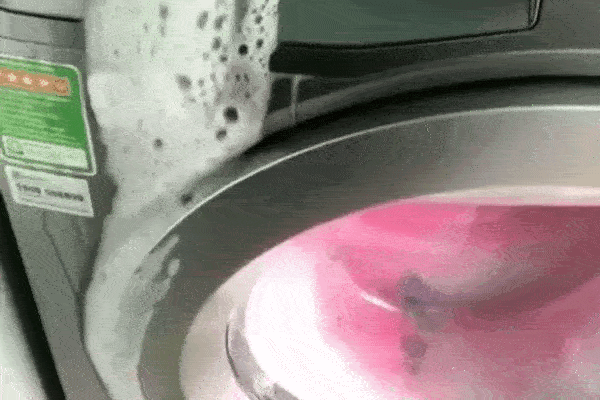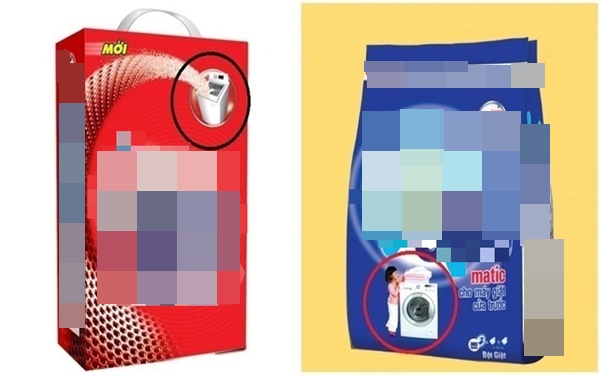In every household today, the presence of electronic appliances is essential. They assist in various household tasks, helping to save time and effort for humans. For example, refrigerators help preserve food for a longer time, keeping it fresh. Cooking stoves make cooking faster and more reliable. And of course, we cannot overlook the importance of washing machines in making laundry more efficient and convenient.
It can be observed that every household owns at least one washing machine. The usage and operations of these machines are relatively straightforward. They are controlled by a panel of buttons on the surface. However, during usage, some user mistakes can lead to problems with the washing machine.
One common example is shown in the image below. The washing machine is still running, but a large amount of soap foam and water is overflowing. This phenomenon not only compromises hygiene but also directly affects the efficiency of the machine, posing a serious risk of electrical malfunction.

A washing machine experiencing severe foam overflow, causing confusion for homeowners
Therefore, at this point, homeowners should quickly disconnect the power to the machine, open the door, clean the foam and water inside and outside the machine floor. Then, restart the machine in a non-spinning mode.
When the machine stops, press the drain button to clean the water inside, ensuring that the soap foam is completely dissolved. Finally, remove all the clothes from the washing machine and repeat the cycle. Running the machine without clothes is a step to allow the device to self-clean and eliminate any remaining soap or residue in the drum and detergent compartment.
Why does the washing machine have foam overflow and water leakage?
According to experienced technicians who have repaired washing machines for many years, foam and water overflow while the machine is running is not uncommon. Foam and water can overflow from inside the drum or from the detergent compartment of the device.
As mentioned above, if the washing machine experiences foam or water overflow for a long time and at a high frequency, it will compromise hygiene, safety, the user’s space, the machine’s shell may rust, and the water drainage pipe may become clogged. The longevity of the device will also be significantly reduced.
There are several causes for this issue, such as using inappropriate detergents for the machine, using the wrong type of detergent, using an excessive amount of detergent, or improperly installing the washing machine.
1. Using inappropriate detergents for the machine
Currently, various detergents are used in washing and cleaning clothes, such as laundry detergent, washing powder, or multi-functional washing pods. Many users assume that any detergent can be suitable for both hand washing and machine washing. However, this is not the case.
According to reputable appliance stores, the amount of foam generated by hand washing powders during the washing process can make the environment inside the machine damp, leading to foam overflow. Therefore, it is better for users to carefully check the types of washing powders before purchasing. It is recommended to buy powders explicitly labeled as suitable for washing machines.

Choose appropriate detergents for machine washing
This not only helps prevent foam overflow but also improves the efficiency of the washing machine and ensures cleaner clothes. It also ensures the longevity of the device when used with suitable detergents.
For multi-functional washing pods, manufacturers and distributors state that they are suitable for both hand washing and machine washing. However, users should follow the proper procedure of putting the pods directly into the drum instead of placing them in the detergent compartment.
2. Using an excessive amount of detergent
A common mistake stemming from the misconception of users is that the more detergent they use, the cleaner the clothes will be and the better the washing performance. However, this not only causes unnecessary waste but also leads to severe foam overflow. Putting an excessive amount of detergent into the machine will overload it and prevent it from dissolving and processing the detergent properly, resulting in overflow.
Therefore, users should only use an appropriate amount of detergent based on the amount of laundry to be cleaned. According to Cleanipedia, a Home Care brand owned by Unilever, they recommend that users use around 110ml of detergent for daily washing. For heavily soiled laundry, this amount can be increased by 100ml, totaling 210ml.
For fabric conditioners, the recommended dosage is 35ml for regular loads and increased to 52ml for heavily soiled clothes. As for multi-functional washing pods, if the load is around 7kg, one pod will suffice. Only for loads exceeding 10kg would two pods be necessary.
If your clothes have stubborn stains or are heavily soiled, you can pre-wash them by hand before using the washing machine.
3. Improper installation of the washing machine
An additional factor that can cause foam overflow is improper initial installation of the washing machine. The machine might not be installed on a level surface, or the water drainage pipe might not align with the machine or be clogged. Therefore, users should ensure the proper installation of the device as soon as they acquire it.
In addition, experts recommend a few points that homeowners should pay attention to during the usage of the washing machine to ensure its effectiveness and longevity:
– Do not place the machine in low humidity or high humidity areas, as this could cause circuit blockage or damage to the control panel of the device.
– Regularly check, maintain, and clean the device. The parts that need particular attention include the water drainage pipe, the door seal, the detergent tray, and the drum. Inspection and maintenance should be conducted every 4-6 months, while cleaning should be done monthly.
– When the machine has operational issues such as loud noise during operation, incomplete washing, or unpleasant odor, contact repair services for timely solutions.
According to Phụ Nữ Việt Nam (Vietnamese Women)
Exploring the Causes and Solutions for Continuous Water Discharge from a Washing Machine
Is your washing machine suddenly showing signs of a continuous water discharge error? Green Machine has some helpful advice to help you fix this issue and get your clothes looking clean again in no time. Read on for our top tips.






































